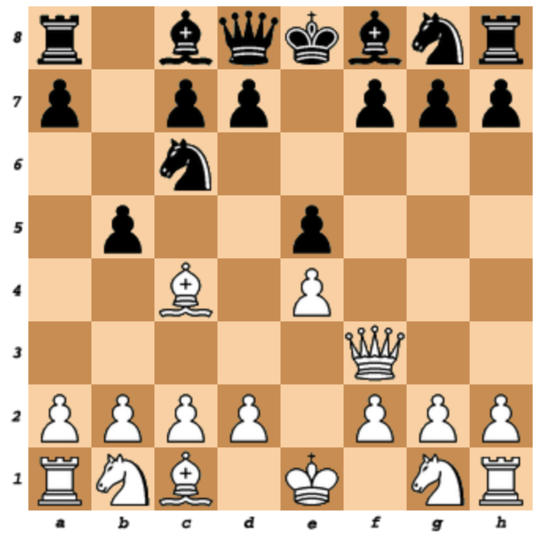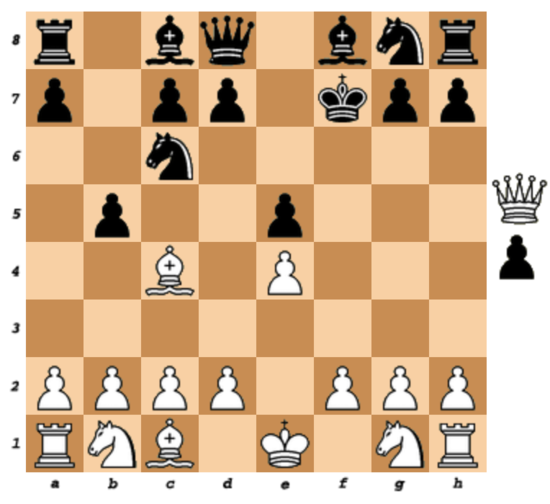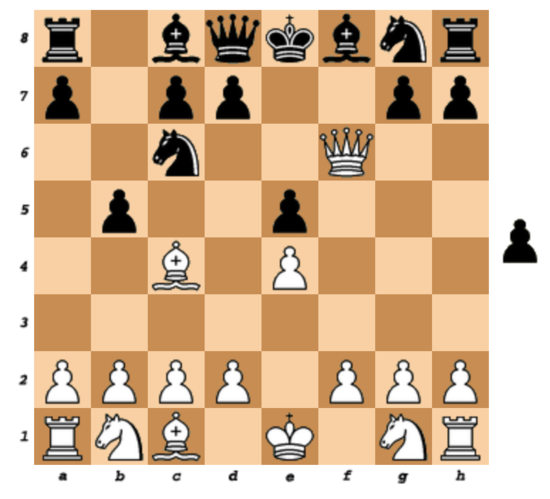David and I played around with the idea of a simultaneous chess variant until we found one that seems balanced. Rules:
- Both players secretly select a move.
- If both can execute without conflict, both do.
- If both can execute only in a specific order, they are executed in that order.
- Otherwise, one move is discarded at random and the other executes.
- You may not choose a move that would end with your king in check, given the current board position.
- You win by capturing or checkmating the opponent's king.
- In selecting a move you choose a maximum number of spaces, but a capture before reaching the maximum counts as a successful move.
- You may select a move if it could be legal after some opponent move. If it ends up not being legal, it doesn't happen.
- To capture en passant you must attempt the capture simultaneously.
- If you are using a clock, it only counts the time between the move selections.
Consider this position:
Say White chooses f3-f7 and Black anticipates that and chooses e8-f7. Black is allowed to make this move because (2) does not apply and (5) does. If we resolved Black's move first then only White's move could happen, but if we resolve White's first then both can happen, so we get the latter:
First White takes the pawn at f7, then Black takes the queen at f7. Alternatively, Black could have selected f7-f6. In that case the only way for both to happen would have been for Black's moved to happen first, at which point (4) means White's queen captures at f6 instead of f7:
This is a bad situation for White, because pawns very powerful. Because a diagonal move only succeeds if it is a capture, (1.3) means Black selecting g7-f6 forces a 50-50 for the White queen. Whereas, if the queen were threatened by any other piece it could just move away (1.2).
In writing this up I found that there is already a Simultaneous Chess variant. That version has a system of "initiative" to handle conflict resolution, which seems like it would play quite differently.
Comment via: facebook



Am I correctly interpreting (2) and (5) as saying that moving into check is legal but selecting a move into check is not legal?
What happens if only one player's move is possible, such as if Black selects e8-f7 and White doesn't attempt capture on f7 at all? Does this result in White's move happening 100% of the time, or is there a 50% chance of no move?
What happens if both moves are possible but the resolution order matters? If White selects f3-f7 and Black selects d8-f6, this could be resolved as Qxf7 followed by Qf6, but it could also be resolved as Qf6 followed by Qxf6. Is one resolution order chosen at random, or is the first one "preferred" because White completes its full move? I'm seems like there could be a situation where both/neither moves can be completed fully but resolution order still matters.
You are correct by my reading. If you could not end up in Check, the game could not end by "capturing or checkmating the opponent's king". Therefore, (2) states that the check for Check is made given the "current board position" at the time of move selection.
By (5), a player choosing a move that could become legal but does not do so forfeits that move.
My question is similar to this, so I'll tack it on here:
How are moves timed? Suppose there were no pawn at d7 in the first position. The moves are revealed as White:f3-f7, Black:c8-f5. Now, does th... (read more)